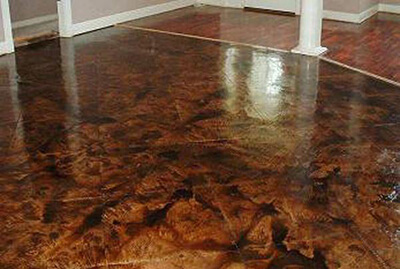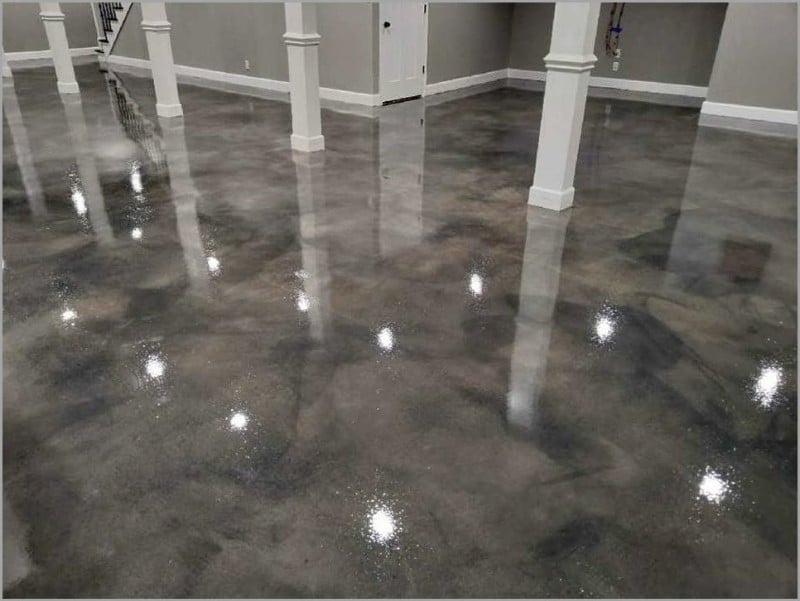All Regarding Stained Concrete: A Comprehensive Overview to Its Advantages and Applications
Stained concrete has actually become a popular selection for both residential and business spaces. Its ability to integrate visual allure with functionality makes it an appealing alternative. Various discoloration methods offer a series of colors and surfaces, permitting modification. The benefits expand past appearance. Understanding its applications and upkeep demands is vital for anybody considering this functional product. The subtleties of stained concrete welcome additionally exploration.
What Is Stained Concrete?

Discoloration can be used to numerous surfaces, consisting of floors, driveways, and patio areas, making it a flexible choice for both interior and outdoor areas. The treatment can achieve a variety of looks, from natural tones to strong, modern designs. Unlike paint, stained concrete preserves its appearance gradually, as it ends up being an indispensable part of the concrete itself. In general, stained concrete works as an effective approach for transforming ordinary concrete right into aesthetically striking surfaces.
Advantages of Stained Concrete
Stained concrete offers significant advantages, particularly in aesthetic charm and sturdiness - Stained Concrete Austin. Its dynamic shades and special patterns boost the visual beauty of any type of room, making it a prominent choice for both property and industrial applications. Furthermore, the durability of stained concrete guarantees that it continues to be a useful financial investment with time, resisting wear and tear
Visual Appeal
Among the most engaging advantages of utilizing stained concrete is its remarkable visual allure. Stained concrete deals a distinct and flexible look that can complement numerous layout styles, from modern-day to rustic. The infusion of dynamic colors and detailed patterns enables house owners and developers to produce tailored surface areas that can improve the general ambiance of a room. Unlike typical flooring alternatives, stained concrete can resemble the appearance of all-natural rock or refined marble, supplying a high end look without the associated prices. In addition, the glossy surface choices can mirror light, additional brightening insides. This adaptability makes stained concrete a preferred option for both household and commercial applications, where aesthetic impact is extremely important.
Resilience and Longevity
The remarkable visual qualities of stained concrete are enhanced by its impressive toughness and long life - Austin Stained Concrete Floors. Stained concrete surface areas are immune to deterioration, making them appropriate for high-traffic areas both inside and outdoors. Their robust nature means they can withstand severe weather, consisting of severe temperature levels, rain, and UV exposure, without significant degradation. In addition, stained concrete calls for minimal upkeep compared to various other floor covering choices, as it does not need regular sealing or refinishing. This long life not just decreases replacement expenses however likewise adds to a sustainable building method. On the whole, stained concrete gives an enduring option that combines aesthetic charm with sensible advantages, ensuring its worth in time
Different Kinds of Staining Techniques
Various staining strategies can noticeably affect the aesthetic high qualities of concrete surface areas. The three key approaches include acid discoloration, which responds chemically with the concrete, water-based staining, which uses a broader series of shades, and overlay staining options that give a fresh surface. Each technique has unique characteristics and applications that satisfy numerous style preferences and task needs.
Acid Discoloration Approach
Exactly how can property owners change plain concrete surfaces right into aesthetically striking functions? One efficient technique is acid discoloration, a preferred strategy that improves the all-natural beauty of concrete. This procedure entails applying a solution of water, hydrochloric acid, and metal salts to the concrete surface. As the acid reacts with the lime existing in the concrete, it produces abundant, variegated colors that look like marble or rock. Acid staining is understood for its sturdiness and resistance to fading, making it a long-lasting option for both indoor and exterior applications. Nonetheless, it is necessary to keep in mind that the results can differ based upon the initial concrete shade and structure - Austin Stained Concrete Floors. Correct application and securing are essential for attaining the preferred visual and longevity
Water-Based Discoloration Strategy
A popular choice to acid staining, check here the water-based staining technique offers property owners a functional way to improve concrete surfaces. This technique uses water-soluble dyes and pigments, enabling for a large range of shades and finishes. Unlike acid stains, water-based stains can be related to unsealed concrete and use a simpler cleanup process. The results can achieve a much more consistent appearance and can be layered to develop one-of-a-kind effects. Furthermore, water-based stains are normally much less hazardous and release less unpredictable natural substances (VOCs), making them a lot more eco-friendly. Property owners may value the capacity to personalize their concrete surface areas with various tones, enabling innovative expression while maintaining longevity and long life in their floor covering options.
Overlay Staining Options
Many overlay discoloration choices exist for homeowners wanting to invigorate their concrete surface areas. One preferred option is acid staining, which reacts chemically with the concrete to generate rich, variegated colors. Another option is water-based discoloration, supplying a broader shade combination and less complicated application. Additionally, concrete overlays can be integrated with stencils for elaborate designs, improving aesthetic appeals. For an extra distinctive coating, house owners may consider making use of stamped overlays that simulate natural products like rock or tile. Each strategy provides distinct advantages, from longevity to modification, enabling for a tailored touch. Eventually, the selection of overlay staining depends on the preferred appearance and the problem of the existing concrete, making certain a revitalized and attractive surface.
Applications of Stained Concrete
Stained concrete deals a functional option for various applications, enhancing both visual allure and functionality. This product is typically utilized in property, business, and commercial setups, making it a popular selection among engineers and developers. In homes, stained concrete can function as stylish floor covering or outside patios, offering an advanced appearance while continuing to be sturdy.
In commercial spaces, such as stores and dining establishments, stained concrete adds to a modern-day atmosphere and can withstand hefty foot web traffic. Furthermore, stained concrete is significantly used in public areas like parks and sidewalks, where its capability to mimic all-natural stone or various other materials includes visual interest.
Additionally, stained concrete is excellent for swimming pool decks and driveways, providing a slip-resistant surface that is easy to preserve. Generally, the versatility of stained concrete makes it suitable for countless atmospheres, satisfying varied preferences and needs.
Maintenance and Look After Stained Concrete
Proper upkeep guarantees the long life and charm of stained concrete surface areas. Normal cleaning is essential; utilizing a mild cleaning agent and water with a soft-bristle brush assists eliminate dirt and gunk without damaging the surface. It is advisable to stay clear of rough chemicals that can strip away the discolor or sealer.
Sealing stained concrete is crucial for defense versus moisture, stains, and wear. A premium sealant should be reapplied each to three years, depending on the website traffic and exposure the surface withstands. Additionally, resolving spills immediately will stop discoloration and staining.

Cost Factors To Consider for Stained Concrete Projects
When preparing a tarnished concrete project, spending plan considerations play an important function in identifying the overall price. The expenses connected with stained concrete can vary considerably based upon numerous factors. The size of the location to be stained straight influences material and labor costs. Bigger rooms will naturally call for more resources. Second, the sort of stain picked-- acid-based or water-based-- can influence pricing, with acid stains often being a lot more costly. Additionally, the intricacy of the layout, including patterns or several shades, can increase labor costs. Preparation job, such as cleaning and grinding the concrete surface, adds to the preliminary costs too. Finally, the choice between DIY installation and employing a specialist service provider will even more impact the budget plan. Understanding these factors makes it possible for home owners to make informed monetary decisions regarding their stained concrete tasks, guaranteeing they accomplish the desired aesthetic within their financial ways.
Tips for Choosing the Right Stained Concrete for Your Area
Picking the appropriate stained concrete for a specific space involves cautious consideration of different factors beyond just budget plan. First, one should examine the desired use the location. High-traffic areas might need more durable finishes, while attractive applications can prioritize looks.
The color palette is an additional essential facet; the selected tones ought to balance with existing decor and lights. It's also important to take right into account the surface texture, as smooth surfaces can boost refinement, while textured options may guarantee safety and security in damp locations.
Neighborhood environment and ecological conditions play a considerable duty in the durability and maintenance of stained concrete, affecting the option of sealers and finishes.
Ultimately, talking to professionals can provide important insights customized to particular needs, guaranteeing the selection of the ideal stained concrete that straightens with both capability and style.

Regularly Asked Concerns
Can Stained Concrete Be Applied Over Existing Floor Covering?
Stained concrete can certainly be applied over existing flooring, offered the surface is stable and adequately prepared. This technique enables for an aesthetic upgrade without the requirement for total elimination of the original floor covering materials.
For How Long Does Stained Concrete Last?
Stained concrete can last for years when correctly maintained. Aspects such as web traffic, environmental problems, and application strategies greatly affect its longevity, with lots of installments remaining dynamic and undamaged for 10 to thirty years.
Is Stained Concrete Slippery When Wet?
Stained concrete can be slippery when damp, as the finish may develop a smooth surface area. Nevertheless, using non-slip additives or textured surfaces can mitigate this issue, enhancing safety without compromising the visual allure of the concrete.
Can I Discolor Concrete Myself, or Should I Employ a Specialist?
The choice to tarnish concrete directly or work with a specialist rest on ability level and job complexity. While do it yourself discoloration can save cash, specialists guarantee suitable results, specifically for complex styles or huge surface areas.
What Colors Are Readily Available for Stained Concrete?
The selection of colors readily available for stained concrete consists of earthy tones like browns and tans, dynamic shades such as reds and blues, and softer shades like pastels. This combination allows for creative, individualized style alternatives.